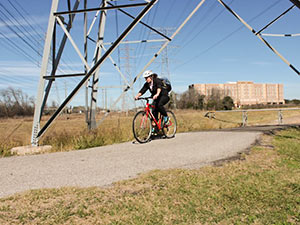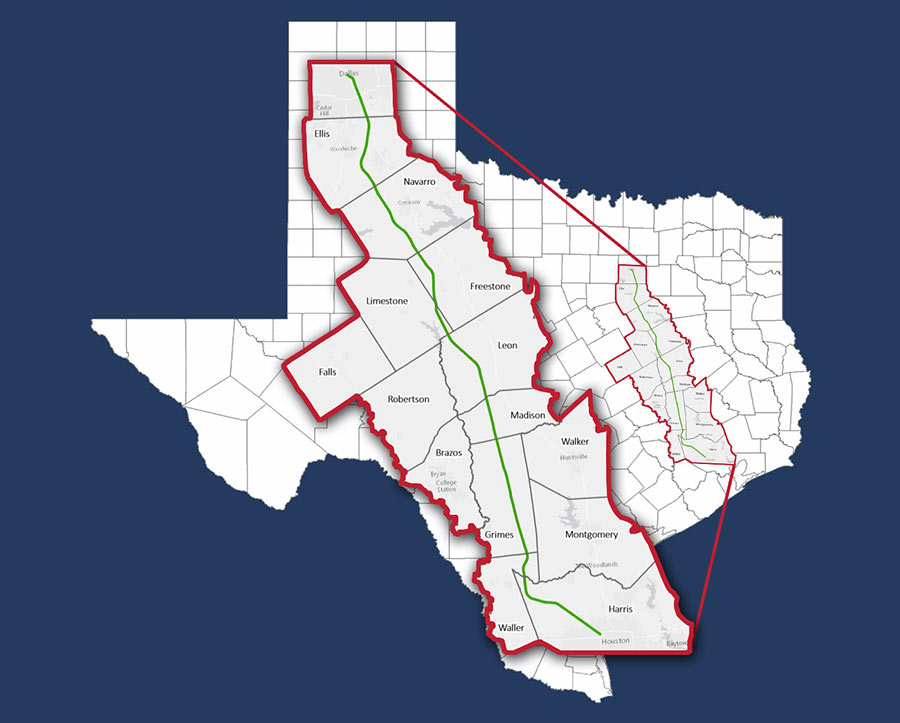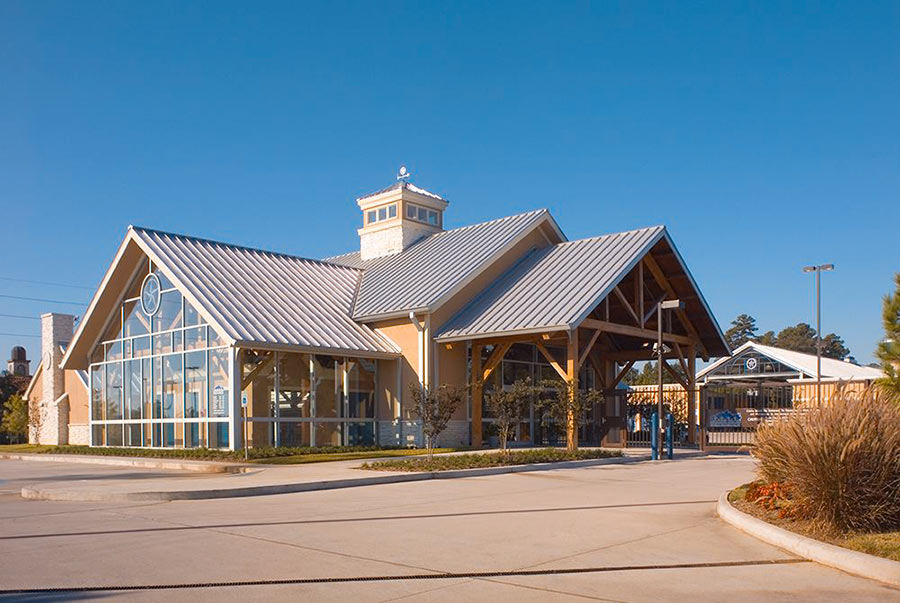HIGH VOLTAGE NEWS FOR HOUSTON BICYCLISTS  Parks and Rec department director Joe Turner tells the Chronicle‘s Mike Morris that a powerline right-of-way crossing on University of Houston property northeast of the intersection of Martin Luther King Boulevard and Old Spanish Trail will be the first improvement allowed by a new agreement between the city and CenterPoint Energy (subject to city council approval this week) that will allow hike-and-bike trails to be cut along electrical transmission-line right of ways throughout the city. Most likely the next up, according to Turner: a trail from Sims Bayou to Cambridge Village Park in southwest Houston. That route, along with others being contemplated, runs north to south. As Mayor Parker noted in her announcement, that should complement the bayou-side (and therefore mostly east-west) trails being created as part of the Bayou Greenways 2020 project. CenterPoint is donating $1.5 million toward the creation of new trails on their property, possibly because it got what it wanted in the deal, which also involves the conversion of all 165,000 city traffic signals to LEDs over the next 5 years. Writes Morris: “Bills to allow trails on utility right of way were filed as early as 2007 but stalled over questions about how much liability CenterPoint should face in opening its land for recreational use. A compromise was reached last year. The utility is liable only for a serious injury or death caused by its ‘willful or wanton acts or gross negligence.’ Under the agreement announced Friday, the city would pay the utility’s legal bills if lawsuits are filed.” [Houston Chronicle ($); more info; previously on Swamplot] Photo of bike trail along Brays Bayou: Dave Fehling/State Impact
Parks and Rec department director Joe Turner tells the Chronicle‘s Mike Morris that a powerline right-of-way crossing on University of Houston property northeast of the intersection of Martin Luther King Boulevard and Old Spanish Trail will be the first improvement allowed by a new agreement between the city and CenterPoint Energy (subject to city council approval this week) that will allow hike-and-bike trails to be cut along electrical transmission-line right of ways throughout the city. Most likely the next up, according to Turner: a trail from Sims Bayou to Cambridge Village Park in southwest Houston. That route, along with others being contemplated, runs north to south. As Mayor Parker noted in her announcement, that should complement the bayou-side (and therefore mostly east-west) trails being created as part of the Bayou Greenways 2020 project. CenterPoint is donating $1.5 million toward the creation of new trails on their property, possibly because it got what it wanted in the deal, which also involves the conversion of all 165,000 city traffic signals to LEDs over the next 5 years. Writes Morris: “Bills to allow trails on utility right of way were filed as early as 2007 but stalled over questions about how much liability CenterPoint should face in opening its land for recreational use. A compromise was reached last year. The utility is liable only for a serious injury or death caused by its ‘willful or wanton acts or gross negligence.’ Under the agreement announced Friday, the city would pay the utility’s legal bills if lawsuits are filed.” [Houston Chronicle ($); more info; previously on Swamplot] Photo of bike trail along Brays Bayou: Dave Fehling/State Impact





Here’s the best and right thing for the City of Houston to do:
1. Vote to have all power lines/utilities buried by 2020, at least ITL (Inside The Loop), and in all business districts.
2. Approve an ordinace mandating that developers include burial of power lines/utilites as part of their developments/projects.
3. Approve an ordinance mandating that all future street/highway widening include burial of power lines/utilities.
4. Approve an ordinance mandating that all future power lines/utilities be buried.
Power lines/utilities above ground are hideous, inelegant and ungrand. The ones along the Hardy Toll Road and along N. Sam Houston Pkwy between I45N and JFK Blvd make me want to puke…bury them already! Some of the nicest streets, communities and vistas are ruined by ugly power lines/utitilities jetting into the sky, many on tacky wooden beams. Come on Houston…time to clean it up…time to bury them.
Not really the same thing HTX.
This is about utility easements, not power lines to individual streets.
That being said, I largely agree with you.
This power line bike path does not impress me. Do these paths go anywhere useful? I don’t know. What I do know is that people riding bikes to work want to ride the most direct route possible. Proper street markings and a public awareness campaign would be a lot more useful than working out a liability issue with Centerpoint.
I like and agree with HTX, but just getting the street repaired in six years would be a miracle. The cost of putting all of Centerpoint’s facilities underground makes such a project impossible. However, new construction should always be put underground. Why overhead drops are installed to free standing meter banks makes zero sense to me.
Burying utility lines and removing poles means even less chance Houston will get fiber internet, thumbs down HTX.
I would love to see all those lovely (heavy sarcasm) utility cables be buried, but the cost of doing so would be tremendous. Not only are the suspended lines an eyesore they also are dangerous, costly to maintain (public tree trimming) and prone to storm damage. Even so, as much as Texas is a “pro-business/screw the people” kind of state I don’t see it happening anytime soon.
To bury a power line is largely a matter of aesthetics.
In terms of loss control and repair, elevated power lines are superior. Elevated power lines are quite resistant to wind and utterly impervious to heavy rain, wind driven rain and rising waters. The major risk of damage to them is mostly from fallen trees. When elevated power lines are damaged, they are much simpler to troubleshoot and repair.
The opposite is true with buried power lines. They are impervious to wind, but have extreme failure modes in heavy rain, wind driven rain and rising water. When they are damaged they are difficult to troubleshoot and repair. After Hurricane Ike, the most expensive and difficult to repair sections of our local grid were the buried sections.
Although it would be very pleasing aesthetically, burying all high voltage lines would be an incomprehensibly expensive and painful clusterf***. Every street a neighborhood power line ran along would have to be taken up and re-paved. Coordinate with every other utility that’s running below ground level when installing. What about the ultra-high-voltage distribution lines that provide power to neighborhood-level service? Keep in mind that this is going to be run by the lowest bidder on a gov’t contract.
You’re talking about a 10+ year, multi-billion-dollar initiative. We don’t even decent resources for homeless people or pet population control, and those are living creatures, not aesthetics. Hell, even citywide fiber like Chatanooga, TN would have a bigger impact per dollar than burying power lines. Wishful thinking for the time being, as much as it would be nice.
Agree with Texasota that utility easements aren’t the same thing that you’re referring to, but I would fully support your ideas and be willing to shell out tax money to make it happen.
I have to agree that the idea of burying electrical wires would be so costly – a nice dream but not practical since it would cost tens of billions of dollars and rip up too many streets.
.
We’re lucky to get some refreshed paint on those fading pavement stripes on Montrose between Richmond and Bissonnet. I’ve been dunning the City to do this for months. I’m tempted to go to Home Depot, buy a gallon of paint, and do it myself. So, I’m not anywhere near holding my breath on burying electric lines.
The segment in question is east of MacGregor Park, along Brays Bayou. And it’s one of the “dead” segments of trailway along that bayou where a large gap exists between existing trails. I guess because the power lines run in the flood control right of way, they needed this agreement before expanding there. Glad it will go in, as I would ride through there more frequently if the hike and bike trail did not end abruptly in MacGregor Park.
Yeah, all those ideas about buried utilities are so far out there that I don’t even read the rants anymore. The $$$$ it would cost could never be met. Now, burying future lines might be possible but there again, the costs to repair and trouble shoot might be prohibitive as others have stated.
.
As for the bike trail, that could work but I’d like to know more of the details about the city’s liability in paying claims for injuries. I’m quite sure that city attorneys would be on top of it but things like “unseen” injuries would or could be bothersome.
The power line trails agreement is a great thing and it going to give Houston a world-class bike and hike grid.
As for the buried utility lines, maybe if the solar pavement invention in the link below ever takes hold it will happen.
http://blog.petflow.com/this-invention/#3SyJJGKqTE21GqMG.01
After Ike, my mom’s house (circa 2002, in a newer neighborhood with underground utilities, 249 @ 1960) got power back within 48 hours (they had to repair the nearest above ground service that fed the subdivision). My old apartment inside the loop, 610 @ Beechnut, with old above ground electric, would have gotten power sooner except for the apartments’ transformers being damaged and needing repair.
Now, my friend’s house, only a few years older than my mom’s, with above ground power lines (circa 1999 or so, 45 @ 1960), did not get power back for almost 10 days, although their below ground phone line worked just fine almost the entire time.
So that basically agrees more or less with the discussion here. The inner city, above ground lines will be repaired quickly, because of the larger number of customers they service, and those poles make future broadband deployment a lot easier.